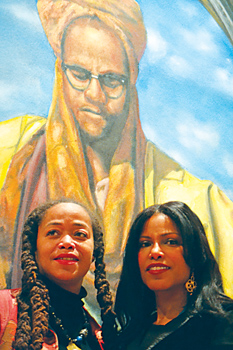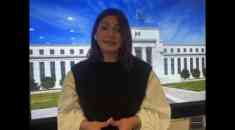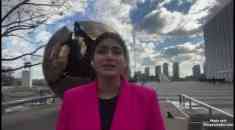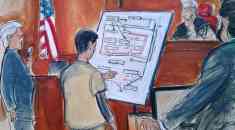A Conduit for People who Love Malcolm All Over the World
- Written by Admin TOA
- Published in Academicians

Sisters Malaak Shabazz (left) and Ilyasah Shabazz keep their parents? spirit alive through the Center. (Photo by Robin Elisabeth Kilmer/Manhattan Times)
As he spoke, Harding was busy preparing the Center for an evening screening and forum discussion, one of many that keeps the calendar packed. Before such events, he makes sure to bring out planks of wood from the Ballroom’s original stage. It was on this stage where Malcolm X gave many speeches, and where he was killed.
Upon Malcolm X’s return from his pilgrimage to Mecca in 1964, he formed the Organization of Afro-American Unity (OAAU). The organization began to hold weekly meetings at the Audubon Ballroom.
On Feb. 21st, 1965, Malcolm X was shot to death on the stage of the Ballroom while delivering a speech.
Oluwole Ifakunole grew up nearby and had parents who attended the Ballroom in the 1950s. During a visit to the Center, he commented on its significance: “So much of African-American history has been wiped out and taken away. Having some semblance of leaving an imprint is important.”
Though she died before the Center’s official inauguration in 2005, Dr. Betty Shabazz served as a key figure in transforming the Audubon into an education center and memorial for her husband. Her daughters Ilyasah and Malaak refer to the venue as “the house that Betty built.”
The sisters note that their mother’s influence is evident in every detail of the center—from the suit Malcolm sported on the first-floor statue, to the direction the crescent on his ring faces in a depiction of him on the floor-to-ceiling mural on the second floor of the Center.
Ilyasah drew the distinction between worshipping her father and learning about his work. Referring to her mother, she said, “It’s good that she was around to lay the foundation. And not so people could glorify him, but so that people could understand his works.” In the years since its founding, the Center has partnered with many community organizations far and wide, and forged an identity as a veritable center of civic, social and cultural life uptown.
The sisters said that the Center reflects their mother’s desires and serves as a place for the people. The sisters say that although there is work ahead, the Center’s mission is fully rooted in their mother’s vision for it to promote education and human rights, and as a space for all to be welcomed.
“We definitely want to have a place where people in the community can feel like it’s theirs,” added Ilyasah. “We want it to be a Mecca in Harlem where everyone can feel loved.” (By Voices of NY | Manhattan Times )
Upon Malcolm X’s return from his pilgrimage to Mecca in 1964, he formed the Organization of Afro-American Unity (OAAU). The organization began to hold weekly meetings at the Audubon Ballroom.
On Feb. 21st, 1965, Malcolm X was shot to death on the stage of the Ballroom while delivering a speech.
Oluwole Ifakunole grew up nearby and had parents who attended the Ballroom in the 1950s. During a visit to the Center, he commented on its significance: “So much of African-American history has been wiped out and taken away. Having some semblance of leaving an imprint is important.”
Though she died before the Center’s official inauguration in 2005, Dr. Betty Shabazz served as a key figure in transforming the Audubon into an education center and memorial for her husband. Her daughters Ilyasah and Malaak refer to the venue as “the house that Betty built.”
The sisters note that their mother’s influence is evident in every detail of the center—from the suit Malcolm sported on the first-floor statue, to the direction the crescent on his ring faces in a depiction of him on the floor-to-ceiling mural on the second floor of the Center.
Ilyasah drew the distinction between worshipping her father and learning about his work. Referring to her mother, she said, “It’s good that she was around to lay the foundation. And not so people could glorify him, but so that people could understand his works.” In the years since its founding, the Center has partnered with many community organizations far and wide, and forged an identity as a veritable center of civic, social and cultural life uptown.
The sisters said that the Center reflects their mother’s desires and serves as a place for the people. The sisters say that although there is work ahead, the Center’s mission is fully rooted in their mother’s vision for it to promote education and human rights, and as a space for all to be welcomed.
“We definitely want to have a place where people in the community can feel like it’s theirs,” added Ilyasah. “We want it to be a Mecca in Harlem where everyone can feel loved.” (By Voices of NY | Manhattan Times )
Last modified onSaturday, 06 May 2017 10:07
Latest from Admin TOA
- Fat Sal’s Italian Specialties Welcomes Customers in Bayville, NJ with a Renewed Concept
- FFD Wood LLC Delivers Custom Woodwork Solutions from Long Island
- A Tax Expert in the U.S. Tax World: An Interview with Samet Oynamıs
- Announcing the 2025 Edition of the 100 Most Influential Turkish Americans
- CEO Club New York Networking Night Stands Out with the Lamborghini Experience









